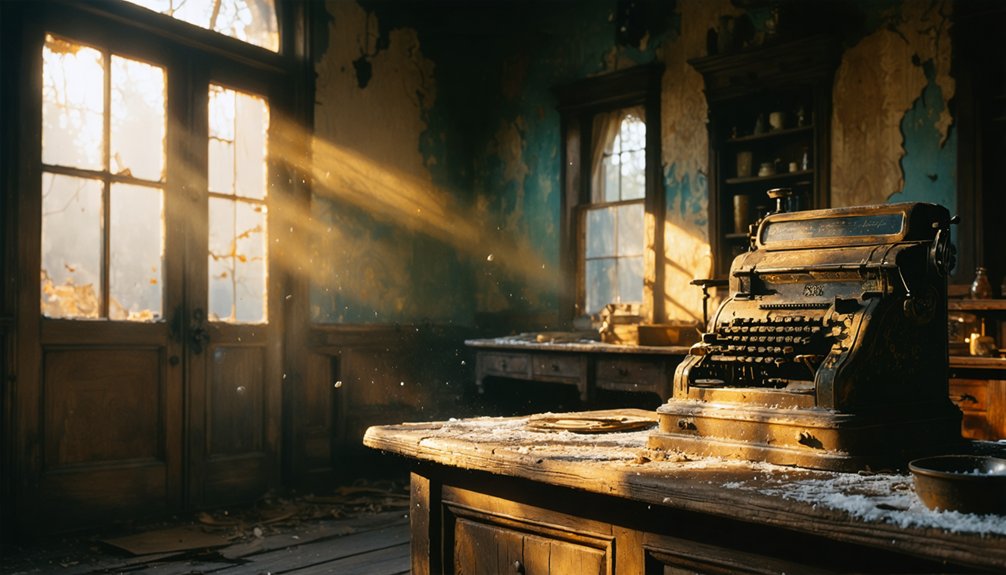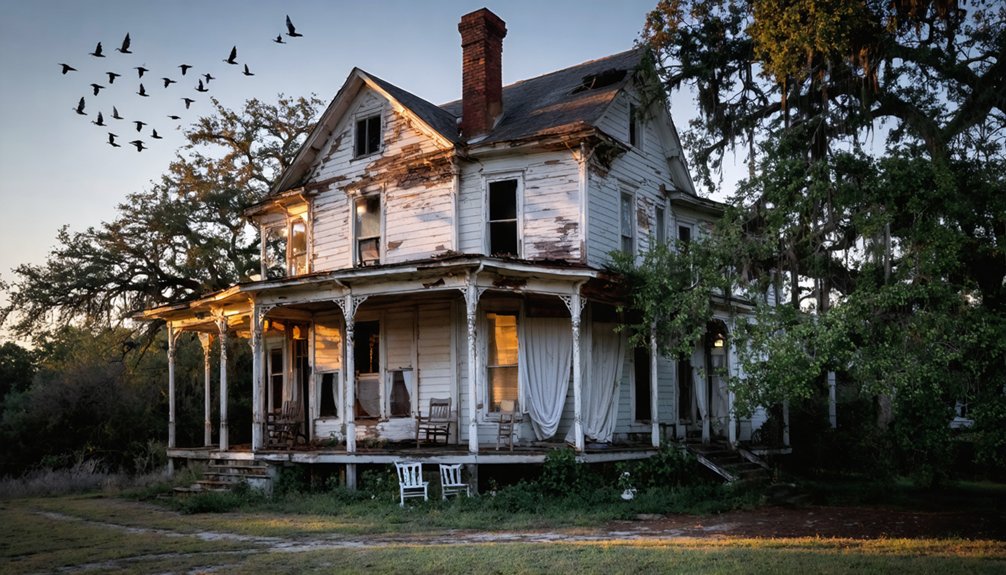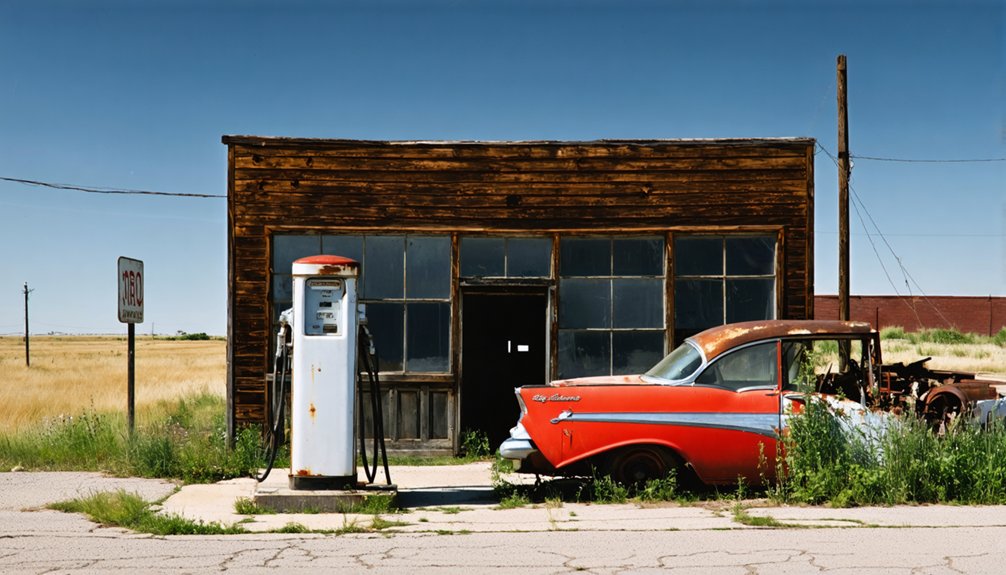You won’t find a ghost town in Sulphur Springs, Texas – it’s actually a bustling city of 16,000+ residents and the Hopkins County seat. While the area’s rich railroad heritage has sparked ghostly legends, including the famous phantom conductor’s light, the city thrives with a diverse economy built on manufacturing, logistics, and food processing. From its 1895 courthouse to Heritage Park’s historical structures, this former healing waters destination maintains deep connections to its past. The supernatural stories you’ve heard are just the beginning.
Key Takeaways
- Sulphur Springs is not a ghost town but rather a thriving city serving as the Hopkins County seat with active economic development.
- The city maintains a vibrant downtown area with preserved historic buildings, including the iconic 1895 courthouse showcasing local heritage.
- Regular community events, festivals, and a bustling cultural scene demonstrate Sulphur Springs’ active, well-populated status.
- The local economy flourishes through manufacturing, logistics, food processing, and tourism, supporting a substantial resident population.
- Despite ghost stories and legends, Sulphur Springs is home to approximately 15,000 residents with modern amenities and infrastructure.
Debunking the Ghost Town Myth
Despite its intriguing name, Sulphur Springs stands as a vibrant, well-populated city that defies any notion of being a ghost town. You’ll find this thriving Texas community serving proudly as the Hopkins County seat, where economic activity and community life flourish rather than fade.
While urban legends and ghost stories may add to the town’s mystique, they’re far from defining its reality. The bustling downtown area, preserved historic buildings, and the iconic Hopkins County Courthouse showcase a community that’s very much alive. The magnificent 1895 courthouse, designed by James Riley Gordon, remains a testament to the city’s enduring architectural heritage. The town square serves as a picturesque gathering place where residents and visitors alike enjoy landscaped areas and walkways.
You can experience the town’s liveliness through its regular community events, active tourism industry, and well-maintained infrastructure. Unlike true ghost towns in the region, Sulphur Springs continues to grow and evolve while honoring its rich historical heritage.
Railroad Legacy and Community Growth
You’ll find Sulphur Springs’ transformation from frontier settlement to thriving community was largely shaped by the arrival of the St. Louis, Arkansas & Texas Railroad in 1887, which connected the town to major markets in Commerce, Sherman, and Fort Worth.
The railroad’s presence established Sulphur Springs as an essential regional hub for commodities like forest products, grain, and steel, while fostering industrial growth through reliable freight transport. Similar to Mt. Vernon’s success, the model train exhibit helps visitors understand the historical significance of rail transportation in the region. Through local development initiatives, the line became a vital part of the Cotton Belt Railway when sold to Jay Gould Interests in 1891.
Even today, through the Northeast Texas Rural Rail Transportation District and Blacklands Railroad operations, the rail legacy continues to influence local commerce and community development.
Rail Hub Economic Impact
When the Texas & St. Louis railroad arrived in Sulphur Springs during the 1870s, you’d have witnessed a dramatic railroad expansion that transformed this rural Texas town into a thriving economic hub.
The rail network’s impact sparked rapid economic diversification, connecting local farmers and ranchers to major markets in Dallas and beyond. The town’s reputation as a healing waters destination attracted countless visitors seeking therapeutic treatments at local bathhouses. The railroad company’s Cotton Belt Route marketing helped establish the town as a key stop along the Missouri-to-Texas line.
- Cotton merchants flocked to warehouses along the tracks, turning the town into a bustling agricultural trading center where wagons lined up for miles to sell their crops.
- Cattle ranchers abandoned risky drives, instead loading their herds onto railcars bound for distant markets.
- Hotels and boarding houses sprung up around the courthouse square, serving travelers and traders who arrived daily by rail.
The rail hub’s presence cemented Sulphur Springs’ position as East Texas’s commercial gateway, supporting industries from steel to plastics.
Tracks Shape Town Growth
The arrival of the East Line & Red River Railroad in 1879 permanently altered Sulphur Springs’ landscape as tracks carved through local farmland and reshaped property boundaries.
Similar to how rail transformed Burnet into a bustling shipping hub, you’ll find evidence of this railway influence east of Holbrook Street, where the line cut directly through the Rountree farm, forever changing local land use patterns.
Today’s local freight carrier, established in 1999, continues this vital transportation legacy.
As you explore downtown, you’ll notice how the entire urban core developed around these steel arteries.
The tracks became the catalyst for town expansion, with businesses and settlements naturally growing outward from the rail corridors.
Property values shifted based on proximity to the rails, while warehouses, hotels, and shops clustered near the depot.
This strategic positioning wasn’t random – it represented a calculated response to the railroad’s magnetic pull on commerce and community development.
Transportation Creates Lasting Community
Progress transformed Sulphur Springs into a vibrant transportation hub when multiple railroad companies established service between 1879 and 1887.
The town’s railroad expansion brought unprecedented economic growth as the East Line & Red River, Texas & St. Louis, and Cotton Belt routes connected you to major markets across the nation. Freedom Rail completed major rehabilitation work in 2020 to modernize key infrastructure.
Today’s community resilience shines through continued rail operations by Blacklands Railroad, moving over 4,000 cars annually.
- You’ll see Century Lake Railroad Bridge standing as a monument to the era’s engineering
- You’ll discover how NETEX’s strategic track purchases preserved essential shipping routes
- You’ll benefit from maintained rail corridors that still support agriculture, manufacturing, and distribution
This transportation legacy endures through infrastructure investments, ensuring Sulphur Springs remains a key regional interchange point for commerce and connectivity.
The Famous Ghost Light Legend
You’ll find the most enduring legend of Sulphur Springs centers on its mysterious ghost light, first reported after a tragic 1883 railroad accident when a conductor lost his head in a late-night collision.
Night after night, locals and visitors have witnessed an eerie, pumpkin-colored orb that floats along the old rail corridor, allegedly the deceased conductor’s lantern as he searches for his missing head. Like other ghost lights, the mysterious phenomenon tends to retreat when approached.
The ghostly phenomenon has drawn curious tourists for generations, transforming this remote spot into an unlikely destination for paranormal enthusiasts and ghost hunters who brave the dark hoping to glimpse the famous light.
Railroad Accident Origins
On August 5, 1922, one of Missouri’s most devastating railroad accidents spawned a lasting supernatural legacy when Missouri Pacific Express Train No. 4 violently collided with Local No. 32 at Sulphur Springs.
You’ll find the tragic roots of the area’s famous ghost lights in these chilling details:
- The express train’s engineer, with 30 years of spotless service, jumped to his death moments before impact.
- Thirty-four passengers perished as rail cars plunged 40-50 feet into Glaize Creek below.
- The crash’s thunderous impact echoed three miles across the countryside.
The catastrophe’s violent end left an indelible mark on Sulphur Springs, where spectral sightings near the accident site continue to this day.
Local folklore attributes mysterious lights along the old rail line to the souls of those lost in this devastating collision.
Night Sighting Reports
Three distinct patterns emerge from early sightings of the mysterious Sulphur Springs light, documented as far back as 1881 when the Houston Daily Post first reported a “lurid light” south of San Antonio.
As a nighttime phenomena, you’ll witness a pinpoint of light that grows to flashlight brightness, often described as pumpkin-colored, before vanishing into the darkness.
The unexplained sightings typically occur after dark, when you’ll need to kill your headlights for the best viewing.
Local witnesses consistently report the orb’s erratic movements – darting rapidly, changing colors, and sometimes approaching vehicles at high speed.
While many visitors leave disappointed, those who’ve encountered the light describe an experience ranging from awe to panic, with each sighting unique in its intensity, movement, and duration.
Local Tourism Impact
The mysterious lights of Sulphur Springs have transformed this quiet Texas ghost town into a thriving tourist destination.
You’ll find the town’s ghost tourism industry driving significant economic growth, with local businesses capitalizing on paranormal enthusiasts‘ fascination with the legendary lights. The phenomenon has sparked development of visitor-friendly infrastructure and specialized tour services, while strengthening the community’s cultural identity.
When you visit Sulphur Springs, you’ll experience:
- Ghost-themed festivals and events that bring the community together while attracting tourists year-round
- Local shops and restaurants featuring unique ghost light merchandise and themed experiences
- Guided night tours to prime viewing locations, complete with historical storytelling and paranormal investigation opportunities
These tourism initiatives have revitalized the local economy while preserving the town’s mysterious heritage for future generations.
Economic Stability Through the Ages
Since its founding as Bright Star in the late 1840s, Sulphur Springs has demonstrated remarkable economic adaptability through multiple transformative eras.
You’ll find a story of agricultural evolution, from the early springs supporting diverse farming to cotton dominance by 1930. When the Great Depression hit, the town’s economic resilience shone through strategic infrastructure investments, particularly in paved roads to attract the dairy industry.
The arrival of Carnation Milk Company in 1937 revolutionized the local economy, establishing the region as Texas’ dairy capital until 1990.
Post-WWII industrialization brought further diversification with manufacturing growth in clothing, mattresses, and petrochemicals.
Today’s economy thrives on a mix of manufacturing, logistics, and food processing, while the equine industry and service sectors guarantee continued stability.
Historical Sites and Preservation

Located at the heart of Sulphur Springs’ heritage preservation, Heritage Park spans 11 acres of meticulously curated historical structures that transport visitors back to turn-of-the-century Texas life.
You’ll find the community’s identity deeply rooted in historic preservation efforts, from the iconic Hopkins County Courthouse with its unique double-helix staircase to the haunted Magic Scoop ice cream shop.
- The 1894 Romanesque Revival courthouse showcases red sandstone and pink granite architecture, complete with its distinctive clockless tower.
- Heritage Park’s authentic collection includes a working blacksmith shop, post office, and gristmill.
- The Hopkins County Museum, housed in the 1910 George H. Wilson home, displays Civil War artifacts and Caddo Indian relics.
The town’s commitment to preservation extends to modern innovations, like America’s first public glass bathrooms with one-way mirrors on the square.
Transportation Hub Success Story
Established as a vital transportation nexus in 1872, Sulphur Springs flourished after the arrival of its first railroad line from Mineola, setting the stage for the city’s remarkable growth as a regional hub.
You’ll find the city’s transportation evolution marked by rapid connectivity advancements. By 1876, the East Line and Red River Railroad connected the city to Jefferson and Greenville, while the St. Louis, Arkansas, and Texas Railway extended northward to Sherman by 1877.
The rapid expansion of railroads in the 1870s transformed Sulphur Springs into a vital crossroads of commerce and connection.
The 1950s brought significant highway developments, including Interstate 30, which complemented the existing rail network. The transformation continued with the award-winning Sulphur Springs Municipal Airport, which now hosts major aviation events attracting hundreds of aircraft annually.
This multi-modal accessibility helped local industries thrive, particularly the dairy sector, which expanded from minimal operations to become the county’s leading milk producer by 1950.
Local Folklore and Cultural Heritage

Supernatural whispers echo through the streets of Sulphur Springs, where ghost stories and local legends have become deeply woven into the town’s cultural fabric.
You’ll find ghostly encounters seamlessly integrated into everyday life, from The Magic Scoop‘s friendly “Charlie” to the mysterious female spirit browsing through purses. These tales hold deep cultural significance, drawing curious visitors while preserving local history.
- At The Magic Scoop, employees regularly witness a male figure in black pants and brown shoes roaming the office where a 1930s murder took place.
- Downtown shops embrace their spiritual residents, with objects moving mysteriously and unexplained phenomena becoming part of daily business.
- The legacy of nearby ghost towns like “Who’d Thought It” and Tinrag adds another layer to the region’s rich supernatural tapestry.
Population Patterns and Development
Since its humble beginnings as “Bright Star” in the late 1840s, Sulphur Springs has evolved from a small pioneer settlement of 441 residents into a thriving regional hub of over 16,000 people.
The city’s population trends reflect steady growth over 170 years, transforming from a rural outpost into a dynamic urban center. You’ll notice this urban evolution in the revitalized downtown district, which now boasts 80% occupancy following extensive redevelopment in the 2000s.
While neighboring settlements like Tinrag and Who’d Thought It faded into obscurity, Sulphur Springs continued to expand its boundaries and services.
The city’s infrastructure now supports both residential and commercial growth, featuring 3,000 acres of parks, multiple hotels, numerous restaurants, and a modern hospital.
Modern Day Vitality and Tourism

Today, Sulphur Springs stands as a vibrant tourist destination, drawing visitors with its unique blend of historic charm and modern attractions.
You’ll find several local attractions that showcase the town’s distinctive character, from the famous glass restrooms to the bustling Sulphur Springs Square, where art galleries and live music create an energetic atmosphere.
The community events calendar stays packed with activities like the seasonal Celebration Market and Bison Fest.
- Stroll through Coleman Park’s natural trails before heading to Cooper Lake State Park for camping and fishing
- Experience the town’s cultural scene at Sulphur Springs Square’s art galleries and live music venues
- Explore the Southwest Dairy Center & Museum while sampling local craft beers at the brewery
Frequently Asked Questions
What Native American Tribes Originally Inhabited the Sulphur Springs Area?
You’ll find the Caddo were the primary inhabitants, known for their cultural significance around the Sulphur and Sabine Rivers. Later tribal migrations brought Comanche influence, though they weren’t permanent settlers.
How Did the Natural Springs Influence Early Medical Treatments?
You’ll find early doctors prescribed the healing waters for various ailments, as they believed the springs’ medicinal properties could treat everything from skin conditions to respiratory problems through bathing and drinking cures.
What Role Did Agriculture Play in Early Settler Communities?
You’ll find early settlers relied heavily on diverse farming techniques, combining cotton cultivation with livestock raising. They cleared fertile lands near springs, establishing sustainable food sources and trade opportunities that powered community growth.
Which Historic Buildings in Downtown Survived the 1950S Modernization?
You’ll find several historic buildings maintained through architectural significance and preservation: the 1895 Romanesque Revival Hopkins County Courthouse, City National Bank, First United Methodist Church, and the Old Post Office Building.
When Was the First Documented Sighting of Paranormal Activity?
While ghostly encounters near the railroad tracks are part of local lore, you won’t find any formally documented first sightings. The haunted location’s earliest paranormal claims remain rooted in oral tradition and folklore.
References
- https://www.youtube.com/watch?v=z9TTVCkgg5M
- http://www.granburydepot.org/z/biog2/ThorpSpringHistory.htm
- https://frontporchnewstexas.com/2022/10/31/history-of-dillon-texas-ghost-town/
- https://www.jstor.org/stable/536255
- https://frontporchnewstexas.com/2022/10/31/history-of-tinrag-texas-ghost-town/
- https://www.tshaonline.org/handbook/entries/whod-thought-it-tx
- https://www.texasescapes.com/EastTexasTowns/Birthright-Texas.htm
- https://www.texasescapes.com/EastTexasTowns/Tinrag-Texas.htm
- https://mansfieldphoto.com/small-towns-of-texas/sulphur-springs-texas-tale/
- https://frontporchnewstexas.com/2022/10/31/history-of-whod-thought-it-texas-ghost-town/



